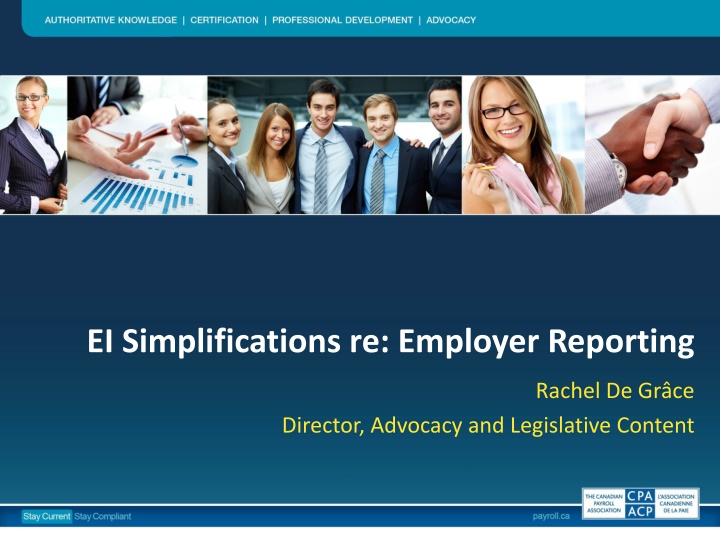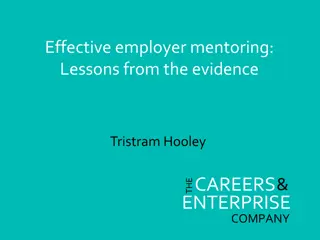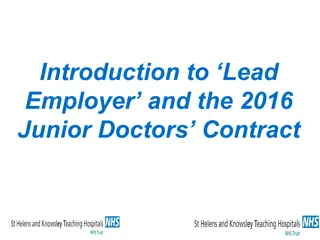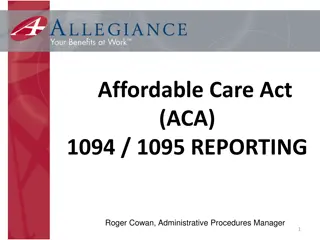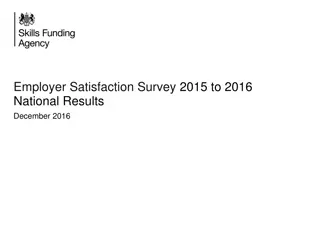Simplifying Employer Reporting for Improved EI Benefit Delivery
This presentation covers the current administrative burdens on employers regarding the production and usage of Records of Employment (ROEs). It highlights challenges faced by small and large employers, provides recommendations for simplification, and suggests changes in ROE requirements and the Reason for Separation (RFS) provision. The focus is on reducing complexity, improving compliance, and enhancing EI benefit eligibility determinations.
Download Presentation

Please find below an Image/Link to download the presentation.
The content on the website is provided AS IS for your information and personal use only. It may not be sold, licensed, or shared on other websites without obtaining consent from the author.If you encounter any issues during the download, it is possible that the publisher has removed the file from their server.
You are allowed to download the files provided on this website for personal or commercial use, subject to the condition that they are used lawfully. All files are the property of their respective owners.
The content on the website is provided AS IS for your information and personal use only. It may not be sold, licensed, or shared on other websites without obtaining consent from the author.
E N D
Presentation Transcript
EI Simplifications re: Employer Reporting Rachel De Gr ce Director, Advocacy and Legislative Content
Agenda Current administrative burden on employers Recommendations for simplification and improved EI benefit delivery Record of Employment (ROE) Request for Payroll Information 2
ROE Production vs Usage 9.5M ROEs 2M used for integrity purposes 1M used for EI claims 6.5M not used for EI purposes 3
Record of Employment (ROE) Small employers that rarely produce ROEs challenged with compliance due to complexity ROE required for every separation of employment of 7 days or more Regulated for determination of EI benefit eligibility, rate, and duration Larger employers with hundreds of interruption of earnings Complex form with 50-page user-guide 4
Recommendation #1: Only require ROE for separation reasons that result in EI claims Do not require ROE for: Quit (e.g., to take another job with another employer)* Death Retirement *For the rare cases of employees quitting and still being eligible for EI benefits (e.g., constructive dismissal), ROEs could be produced on request as part of the current investigation process 5
Reason for Separation (RFS) Currently, employers must provide (RFS) in all situations, even when separation was employee-initiated Including more private matters, such as relocating with spouse Not all employee-initiated separations result in a benefits claim Such as to take another job with a different employer Employers are rarely in situation to confirm personal employee reason 6
Recommendation #2: Employer and Employee- Provided RFS If separation is employer initiated: Employer to provide RFS If separation is employee initiated: Employee to provide RFS when applying for benefits 7
Allocation of Earnings and Hours Allocation of earnings / hours to a specific pay period based on a long list of earning types in ROE Guide Distinguishing whether these should be allocated to the pay period in which paid, for which paid, or final pay period each requiring separate programming and often manual manipulation This penny-perfect requirement is often a derived number and subject to miscalculation and/or allocation 8
Complex Allocation of Earnings and Hours Allocated to pay period for which they are paid* (e.g., Vacation pay, where vacation time is taken, however paid) *Allocate the earnings you pay to an employee to the pay period for which the employee earned them. In the case of leave taken, allocate the earnings to the period of leave. 9
Complex Allocation of Earnings and Hours (continued) Allocate to pay period in which they are paid (e.g., Vacation pay, where no vacation time is taken, however paid) Last period of regular wages (e.g., vacation pay paid on separation) 10
Recommendation #3: More Consistent Allocation Service Canada to use standard and consistent allocation of earnings and hours to the EI history period 11
Definition of a Week S.2 of EI Act:Any 7 day period beginning on Sunday Requests for Payroll Information require payroll data on a weekly Sunday to Saturday basis Less than 3% of employers pay employees on a weekly Sunday to Saturday frequency* * 2011, 2014, 2017 CPA Member Census Surveys; 2010-2018 NPW Surveys 12
Request for Payroll Information Does not accept over 97% of employers payroll data without employer manipulation Small employers challenged by lack of resources to perform time- consuming manipulation of data Large employees challenged by volume of Requests, with requirements often going back 2-3 years 13
Recommendation #4: Use of Real Employment Data Enable employers to complete Requests for Payroll Information using actual payroll frequency Save employers hundreds of thousands of hours 14
Premium Reduction Program (PRP) 2014 CPA Survey with almost 6,000 responses 24% of employers with short-term disability plan do not participate in PRP (58% of small employers) Administration outweighs incentive Unaware 16
Recommendation #5: Increase Awareness of PRP Insurance companies/ third party administrators/ brokers should promote advantages of PRP as effectively reducing cost of offering STD Clear information, designed by size of employer Employers need clear picture of premium reduction they could qualify for and what reduction will likely be if they add additional wage loss benefits for employees Rates and Multiples table should provide definitions of the four categories 17
Unanticipated Consequences of 1-Week Waiting Period Higher benefits administration and employees often back to work by the time claim is adjudicated Dramatic increase in STD claims since change to 1-week waiting period Employers now reconsidering maintaining STD plan 18
Employer Costs Far Outweigh Incentive Reduced Employer EI Rate 19
Employees Benefit Twice 100% employer- paid sick leave benefit from employer 5/12 share of employer s reduced EI incentive 20
Recommendation #6: Enhance PRP Incentive Employer should be entitled to 100% incentive; or Employer typically pays 100% of STD plan Employer s cost of STD premiums should be put toward satisfying the 5/12 21
Win-Win-Win Increasing PRP incentive and awareness would benefit: Employer (especially smaller employers who must compete with larger employers who already offer disability benefits) Employee (STD benefits are often paid at a higher rate than 55% of the Maximum Insurable Earnings) Federal government through fewer claims for sick benefits 22
